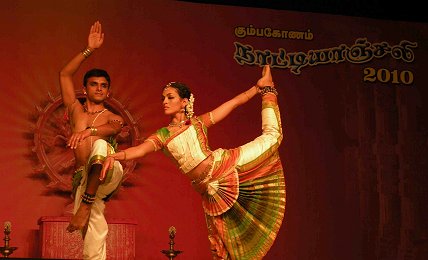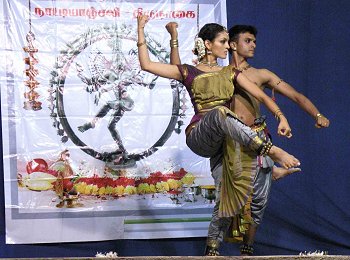
|
 |

|
 |
The Natyanjalis - Rukmini Vijayakumar, Bangalore e-mail: raadhakalpa@gmail.com March 23, 2010 The classical Indian dancer exists purely out of the passion and love that the dancers have for their art. It offers no monetary gain, no substantial fame or media recognition, but just the fulfillment of dance itself. The Natyanjali festivals that are organized across the temples in Tamil Nadu are a standing example of how dancers flock to perform in a place where their art is understood, appreciated and watched with rapt attention. The temples offer a spiritual ambience that supports our art. Dr. Padma Subrahmanyam always says that "wherever we dance, that place is automatically sanctified and becomes a temple." In the Natyanjalis, the temple that we create with our dance in union with the temple that the devotees create from their devotion and prayers, resonate and create in us an experience that magnifies itself in the spiritual context. Audiences in the thousands come to the temples during Shivratri and watch the dancers perform traditional Indian classical dance. A large, attentive audience for the classical arts is difficult to find in the metropolitan cities of India today; unfortunately because the youth is so influenced by the west that they have no connection to their cultural roots. But, we must remind ourselves, that India is not only in the metropolitan cities that we live in. India is in the smaller towns and the villages making the mass of the population still "Indian" in thought and culture. My dance partner Parshwanath Upadhye and I had the opportunity to perform at the Natyanjali festivals earlier this month and it was heartening to see that so many people still watch classical Indian dance with interest and attention. Not only do they watch, but they are culturally aware enough to understand our stories of Shiva, and laugh at the comic moments and be moved with emotion when Shiva protects his bhaktas. We traveled through Mayavaram, Tanjavur, Tirunallar, Nagapattinam and Kumbakonam, driving from one place to another to be greeted by warm smiling faces and organizers that were happy to have another dancer that is devoted to the art amongst them. 

We began our journey at Mayavaram or Mayiladuthurai, a place that got its name because of the dancing peacocks that offer their prayers to Lord Shiva. The Devi sanctum was mesmerizing. I stood and stared for several minutes at the beauty of the sculpture, lit only by the lamps and decorated with flowers. I am actually unable to recollect other details because the Devi took all my attention. I realize that this is why I dance; this is why we all dance. To be one with ourselves, to be one with the devi within us; the Lord Shankara that allows us to meditate upon him through our dance. The friendly organizers at Mayiladuthurai accompanied us to the temple as well as to lunch and ensured our comfort throughout our stay. We then drove to Tanjavur from Mayiladuthurai. I had been to the Brihadeeshwara temple at Tanjavur as a teenager and could remember the beauty and magnificence of the structure. I was looking forward to dancing there. Our duet performance inaugurated the Shivratri festival at Tanjavur. The stage was within the premises of the large temple and the audience sat all around us. It was a bit of a struggle maneuvering through the crowds to reach the stage to perform, but dancing in one of the most beautiful temples in India made up for all the 'maneuvering.' We left the following morning to dance at Thirunallar and Nagapattinam. The Thirunallar audience was one of the most receptive and interactive audiences we have ever experienced. It was informal, and Mr. Mahadevan was friendly and kept fixing the mat that was moving as we danced on stage. There were so many small children in the audience that laughed loudly at the little 'dance jokes' and the audience sat attentive all through. The temple purohits showered us with extra vibhuti when they knew we were to perform. At the conclusion of our performance, the small children followed us till our car, a little shy, but constantly congratulating us with a smile spread across their faces. From Thirunallar, we went directly to Nagapattinam, to perform again the same day! We unfortunately were not able to go into the temple as our performance was late, but again, it was a beautiful experience to perform there, and be welcomed by such affectionate people. Our last performance was in Kumbakonam. The towering ornate gopuram was in view behind the stage. We began dancing at 11pm and still there was a full audience, watching with interest. The coordinators were all dressed in matching purple sarees and had the announcements down pat. The imposing gopuram and the ambience gave us renewed vigor for our last performance in the Natyanjalis. This travel that I took with my eternal support, my mother and my dance partner, has been one that we will not forget. It remains like an ethereal memory, a picture etched in our minds forever. Throughout our travels these five days, we saw that many people came from across India, as well as from across the world to perform on these stages. What exactly brings dancers from across the globe to dance here? It is something that can't be explained in words but must be felt. In all these places, the stage might not be made of polished wood, and the lighting may not be the best and the accommodation might not be in a five star hotel, but the fondness of the people, the grandeur of the temples and the adoration of the audiences is so great that all the technical inadequacies are of no importance. All we have to do is dance with a full heart. Rukmini Vijayakumar (disciple of Padmini Rao and Guru Narmada) is a Bangalore based Bharatanatyam dancer. She has studied Laban movement analysis, Alexander technique and is a certified Pilates instructor of the Power Pilates institute. Rukmini has a new dance company Raadha Kalpa. |